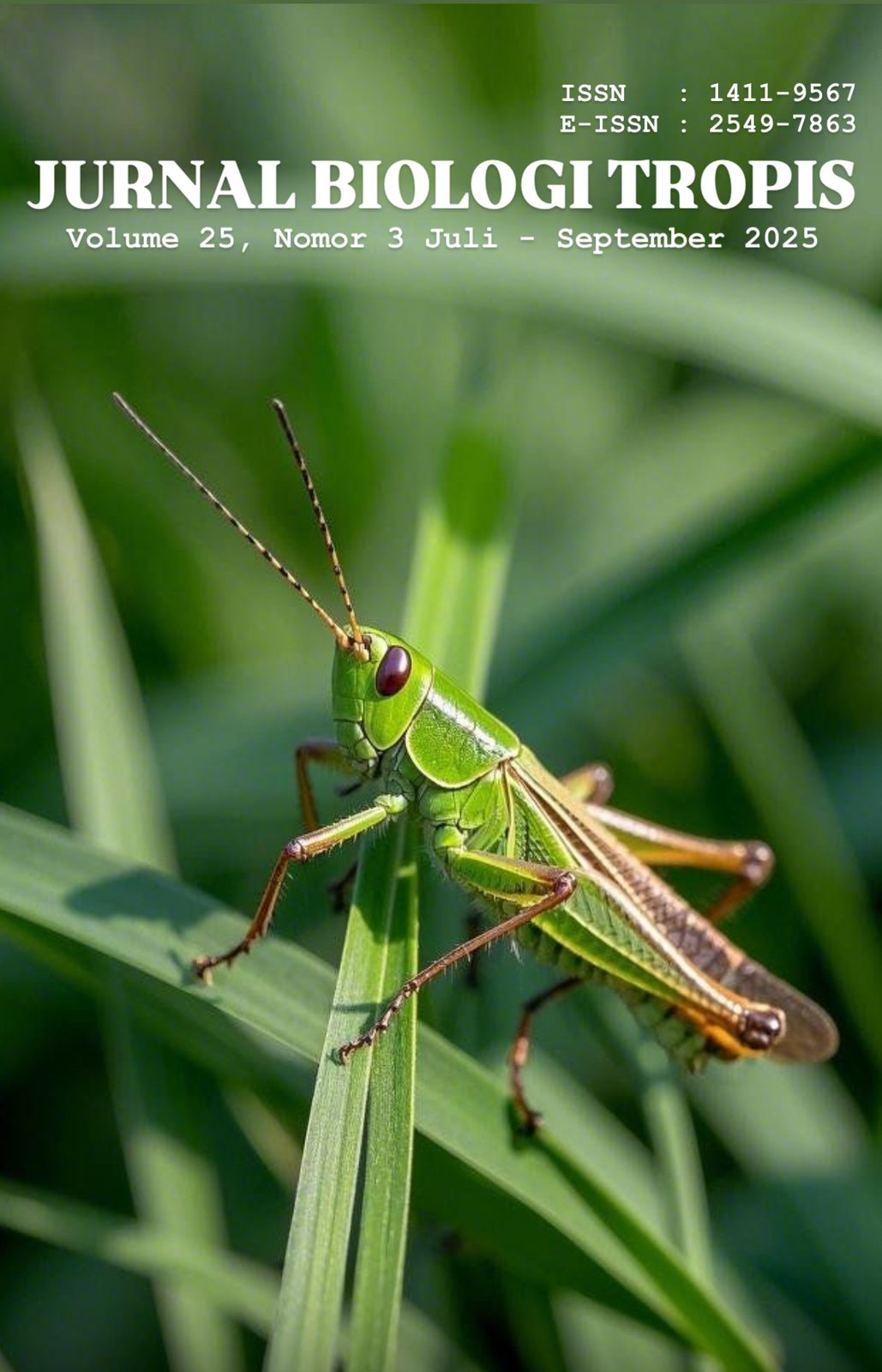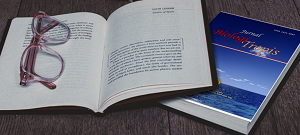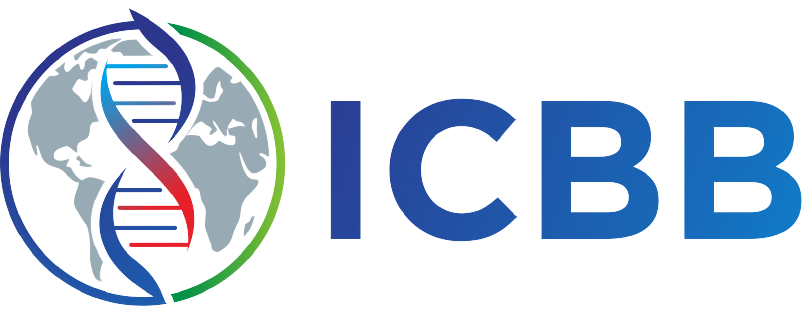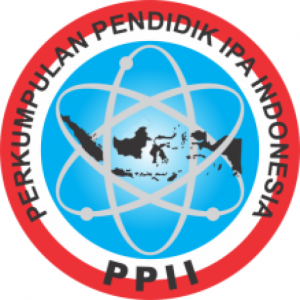Supporting Habitat Contribution to Reef Fish Diversity in Sekotong Bay, West Lombok, Indonesia
Authors
Vita FitriantiDOI:
10.29303/jbt.v25i3.9137Published:
2025-07-15Issue:
Vol. 25 No. 3 (2025): Juli-SeptemberKeywords:
Community structure, coral reef fish, Sekotong Bay, species diversity, species richness, supporting habitatsArticles
Downloads
How to Cite
Downloads
Metrics
Abstract
Habitat complexity plays a crucial role in shaping the diversity and structure of coral reef fish communities by offering a range of ecological niches for feeding, reproduction, and shelter. This study investigates how different levels of habitat complexity, particularly the presence of supporting habitats such as seagrass beds and mangroves, influence the richness and diversity of coral reef fish communities in Sekotong Bay, Lombok, Indonesia. Data were collected at four stations using the Underwater Visual Census (UVC) method, with observations focusing on habitat parameters, substrate complexity, and anthropogenic activity. Results showed that stations with buffer habitats —mangroves at Station III and seagrass beds at Station IV— exhibited significantly higher species richness and diversity indices compared to other stations. Seagrass beds, in particular, were associated with the highest diversity (H' = 2.95; 42 species), suggesting their key role in maintaining fish community structure. Although Station IV experienced human activity, it still supported a complete community structure, including target fish species, highlighting the ecological buffering capacity of adjacent seagrass habitats. These habitats not only function as nursery grounds and sediment filters but also sustain the ecological balance and resilience of coral reef ecosystems. The study also found that river mouths may negatively affect benthic substrate diversity due to sedimentation unless mitigated by buffer vegetation. Overall, findings underscore the importance of preserving habitat complexity and integrating seagrass and mangrove protection into coastal management strategies to enhance biodiversity, ecosystem stability, and local socio-economic resilience.
References
Bachtiar, I. & Hadi, T. A. (2019). Differential Impacts of 2016 Coral Bleaching on Coral Reef Benthic Communities at Sekotong Bay, Lombok Barat, Indonesia. Biodiversitas, 20: 570-575. DOI: 10.13057/biodiv/d200237
Bachtiar, I., Suyantri, E., Lestari, T. A. & Ghafari, M. I. A. (2024). Intertidal Echinoderm Identification Keys for A Reef-Walking-Tour at Mandalika, Lombok Island, Indonesia. Biodiversitas, 25: 1965-1974. DOI: 10.13057/biodiv/d250513
Camp, E. F., Suggett, D. J., Gendron, G., Jompa, J., Manfrino, C. & Smith, D. J. (2016). Mangrove and Seagrass Beds Provide Different Biogeochemical Services for Corals Threatened by Climate Change. Frontiers in Marine Science, 3: 52. DOI: 10.3389/fmars.2016.00052
Carlson, R. R., Evans, L. J., Foo, S. A., Grady, B. W., Li, J., Seeley, M., Xu, Y. & Asner, G. P. (2021). Synergistic Benefits of Conserving Land-Sea Ecosystems. Global Ecology and Conservation, 28: e01684. DOI: 10.1016/j.gecco.2021.e01684
Dewsbury, B. M., Bhat, M. & Fourqurean, J. W. (2016). A Review of Seagrass Economic Valuations: Gaps and Progress in Valuation Approaches. Ecosystem Services, 18: 68-77. DOI: 10.1016/j.ecoser.2016.02.010
Dung, Q. L., Siau, Y. F., Kentaro, T., Suhaimi, S., Yuji, S. & Kotaro, S. (2020). Feeding Habitats of Juvenile Reef Fishes in A Tropical Mangrove–Seagrass Continuum along A Malaysian Shallow-Water Coastal Lagoon. Bulletin of Marine Science, 96: 469-486. DOI: 10.5343/bms.2018.0093
Fitrianti, V. & Ghafari, M. I. A. (2021). The Study of Reef Fish Community in the Outer Islets of Sekotong Bay, Indonesia. IOP Conference Series: Earth and Environmental Science, 739: 012074. DOI: 10.1088/1755-1315/739/1/012074
Fitrianti, V. & Ghafari, M. I. A. (2023). Tiny and Everywhere: Microplastic Density and Distribution in Sediments along the West Coast of Lombok Island, Indonesia. Philippine Journal Science, 152: 1677-1686. DOI: 10.56899/152.05.12
Ghafari, M. I. A. & Fitrianti, V. (2021). Pioneer Assessment on Megabenthic Community Suggest the Recent Ecological Condition of Coral Reef in Senggigi Beach, Western Lombok Island, Indonesia. Indo Pacific Journal of Ocean Life, 5: 14-21. DOI: 10.13057/oceanlife/o050103
Ghafari, M. I. A. (2024). Recurrence of Severe Coral Bleaching in Bidong and Karah Island, Peninsular Malaysia: Mid-2024. Galaxea, Journal of Coral Reef Studies, 26: 48-49. DOI: 10.3755/galaxea.G26N-8
Giyanto, Manuputty, A. E. W., Abrar, M., Siringoringo, R. M., Suharti, S. R., Wibowo, K., Edrus, I. N., Arbi, U. Y., Cappenberg, H. A. W., Sihaloho, H. F., Tuti, Y. & Zulfianita, D. (2014). Panduan Monitoring Ekosistem Terumbu Karang. LIPI Press, Jakarta.
Hasim. (2021). Mangrove Ecosystem, Seagrass, Coral Reef: Its Role in Self-Purification and Carrying Capacity in Coastal Areas. International Journal Papier Advance and Scientific Review, 2: 37-49. DOI: 10.47667/ijpasr.v2i1.93
Henseler, C., Nordström, M. C., Törnroos, A., Snickars, M., Pecuchet, L., Lindegren, M. & Bonsdorff, E. (2019). Coastal Habitats and Their Importance for the Diversity of Benthic Communities: A Species- and Trait-Based Approach. Estuarine, Coastal and Shelf Science, 226: 106272. DOI: 10.1016/j.ecss.2019.106272
Japa, L., Fitrianti, V., Rohimah, S., Wadi, H. & Abendani, R. (2020). Kondisi Ekosistem Mangrove di Teluk Sekotong, Kabupaten Lombok Barat. In: Kesehatan Terumbu Karang dan Ekosistem Terkait Lainnya di Teluk Sekotong Kabupaten Lombok Barat, Bachtiar, I. and A. W. Jufri, (Eds.), Mataram University Press, Mataram.
Jaxion-Harm, J., Saunders, J. & Speight, M. R. (2012). Distribution of Fish in Seagrass, Mangroves and Coral Reefs: Life-Stage Dependent Habitat Use in Honduras. Revista de Biología Tropical, 60: 683-698.
Karnan. (2022). The Impact of Coral Bleaching on Coral Reef Fishes in Sekotong Bay, West Lombok Regency. Jurnal Penelitian Pendidikan IPA, 8: 2670–2674. DOI: 10.29303/jppipa.v8i6.1576
Loke, L. H. L. & Todd, P. (2015). Structural Complexity and Component Type Increase Intertidal Biodiversity Independently of Area. Ecology, 97: 383-393. DOI: 10.1890/15-0257.1
McHenry, J., Rassweiler, A., Hernan, G., Uejio, C. K., Pau, S., Dubel, A. K. & Lester, S. E. (2021). Modelling the Biodiversity Enhancement Value of Seagrass Beds. Diversity and Distributions, 27: 2036-2049. DOI: 10.1111/ddi.13379
Nasution, M. A., Hermi, R., Heriansyah, Lubis, F., Saputra, F., Ammar, E. E. & Akbar, H. (2024). Seagrass Biodiversity and Its Drivers in the Kepulauan Banyak Marine Nature Park, Indonesia. Indonesian Journal of Marine Sciences, 29: 156-169. DOI: 10.14710/ik.ijms.29.1.156-169
Shannon, C. E. & Weaver, W. (1963). The Mathematical Theory of Communication. University of Illinois Press, Urbana.
Smith, R. E., Johnston, E. L. & Clark, G. F. (2014). The Role of Habitat Complexity in Community Development is Mediated by Resource Availability. PLoS ONE, 9: e102920. DOI: 10.1371/journal.pone.0102920
Sukeri, M. S. M., Idris, M. H., Al-Asif, A., Ghafari, M. I. A. & Kamal, A. H. M. (2024). Community Awareness of Benefits of Merchang Mangrove Forest, Terengganu, Malaysia. Malaysian Forester, 87: 217-238.
Tarigan, S. A. R., Aviandhika, S., Adiyoga, D. & Ardiansah, I. (2020). Monitoring Ekosistem Terumbu Karang di Pulau Panjang dan Pulau Saringgit, Kabupaten Sumbawa. Wildlife Conservation Society-Dinas Kelautan Wilayah Sumbawa, Taliwang.
Vaslet, A., Bouchon-Navaro, Y., Harmelin-Vivien, M., Lepoint, G., Louis, M. & Bouchon, C. (2015). Foraging Habits of Reef Fishes Associated with Mangroves and Seagrass Beds in A Caribbean Lagoon: A Stable Isotope Approach. Ciencias Marinas, 41: 217-232. DOI: 10.7773/cm.v41i3.2494
Verweij, M. C., Nagelkerken, I., Hans, I. & Ruseler, S. M. (2008). Seagrass Nurseries Contribute to Coral Reef Fish Populations. Limnology and Oceanography, 53: 1398–1405. DOI: 10.2307/40058274
License
Copyright (c) 2025 Vita Fitrianti

This work is licensed under a Creative Commons Attribution 4.0 International License.

Jurnal Biologi Tropis is licensed under a Creative Commons Attribution 4.0 International License.
The copyright of the received article shall be assigned to the author as the owner of the paper. The intended copyright includes the right to publish the article in various forms (including reprints). The journal maintains the publishing rights to the published articles.
Authors are permitted to disseminate published articles by sharing the link/DOI of the article at the journal. Authors are allowed to use their articles for any legal purposes deemed necessary without written permission from the journal with an acknowledgment of initial publication to this journal.


























